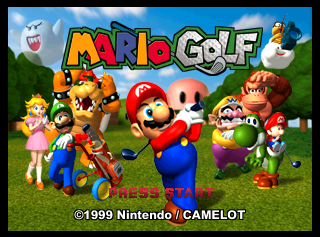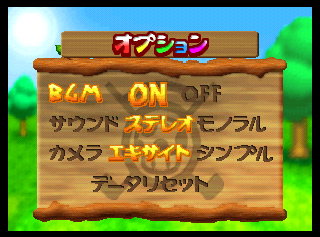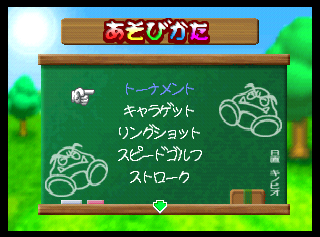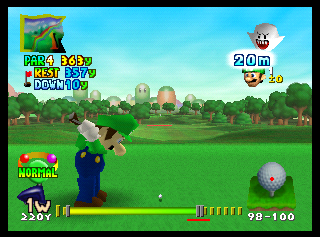Mario Golf (Nintendo 64)
| Mario Golf |
|---|
|
Also known as: Mario Golf 64 (JP)
|
Play golf as your favorite the most powerful Mario characters (and random humans)! Bizarrely, Mario is an unlockable character, at least in single-player mode.
Contents
Sub-Page
| Notes |
Unused Music
| To do: There's an upload on Youtube with this track described as "Hidden Intro Results 2". "Hidden Course Music" is also the same song used in the easter egg described at the bottom of this page. Look into this and see if this track is actually unused and/or if any of this would involve using a transfer pak to unlock something. |
Unused Track
Unused Course Features
Ground Type
There is one unused ground type left in the game, which is the "cartway". It is fully functional, having its own name, properties, image, and appearance still intact. It seems to have been intended as a road of some sort from looking at its lie image, though this is not usually very relevant for a golf course. In behaviour, it is most similar to the "red" ground type, which is used when playing the fast variants of the mini-golf courses; the shot power percentage is 80-100 and it has low friction and a high bounce. It appears as a plain grey patch of ground when loaded on the course during play.
The cartway does appear with similar functionality in the Everybody's Golf games, the first of which was also developed by Camelot.
Dummy Character
| To do: See if the dummy character exists in any way in the NA/EU releases. |
In the Japanese release, there is an unused character named ダミー, which appropriately translates to Dummy. They can be enabled using the GameShark code 810BC84E 000D.
This may be a work-in-progress version of Metal Mario, as their position on the character select screen is the same as Metal's (albeit visually messed up as the overall character alignment is different in the JP release). However, Dummy shares the same stats as Yoshi. Also, their in-game score sprites are Donkey Kong's for some reason, and their animations are unfinished, with the mode select and post-hole animations being the animation Mario uses when preparing to hit the ball. Finally, Dummy does use Mario's alternate costumes, but the icon will not change colors on the select screen.
Debug Features
| This needs some investigation. Discuss ideas and findings on the talk page. |
| This page or section needs more images. There's a whole lotta words here, but not enough pictures. Please fix this. |
By using the following GameShark code, you can access some debug features.
| Japan | 800B0FC0 0001 |
| US | 800B67C0 0001 |
| Europe | 800B6A70 0001 |
| US (LodgeNet) | 800B64F0 0001 |
First thing you might notice is the debug text on the intro cutscene. CAMERA:00 shows the current camera in use and increases in value as the cutscene goes. The numbers on the right are for counting how much time there is left until a camera angle is changed to the next. The numbers on the bottom count how much time has elapsed in the intro cutscene in total.
Using controllers 2, 3 or 4, press Start to display a CPU usage meter of sorts. Pressing it again will display more debug numbers. Presumably, the top number seems to change whenether an action is being done or not. The first row and second rows seems to change when a menu or effects for the UI are loaded. Pressing L will freeze the game, D-Left will cycle through frames and D-Right will resume gameplay.
SRAM Editor
This feature can be accessed by enabling the code above and pressing L + Start during a match. This will display a number of flags, which control various debugging features. There are 256 (FF) flags in total, though not all of them appear to be used. Choose a flag using the D-Pad, enable it by pressing A, or disable it by pressing B. You can also press L or R to go to the first or second page of flags, respectively. All currently-known flags and their functions are described on the Notes page.
Color and Fog Editor
Flag 0x2D activates an editor for the background/sky and fog. On controller 2, use the D-Pad or C buttons to navigate the menu. Press A to increase the currently-selected value, or B to decrease it. The RGBA rows correspond to the colors and the TBC columns correspond to the sky. The BG columns edit the background and the FOG column edits the fog. You can control the fog's thickness by modifying the last row in its column. The option CC:0 is inaccessible, and its purpose is unknown.
Text Color Test
Flag 0x46 displays サンプルABCDEFG on the screen along with a menu in the top-right corner, similar to the menu in the color and fog editor. On controller 2, use the D-Pad to move the text and the C buttons to navigate the menu. Press A to increase the currently-selected value, or B to decrease it. The values in the menu control the coloring of the text; the top row corresponds to the bottom of the text and vice-versa. The columns correspond to the colors cyan, magenta, and yellow, respectively.
Pin Selection Tool / Ball Position Viewer
Flag 0x47 activates a tool that allows you to change the pin location for any hole while the course flyover is occurring. To change the currently selected pin, press L or R on controller 1. Every hole has four possible pin settings, though the mini-golf courses and Driving Range don't define all four and have some pin locations off the map.
Starting gameplay on any hole displays X/Y/Z/Attr values, which seem to be related to the ball's current position and the ground attribute value that it is resting on. These values update when starting a new shot and remain on screen afterwards even when changing game modes.
Playing on a mini-golf hole and hitting a shot that rebounds off a wall (or, sometimes, just loading a mini-golf hole, especially in Training mode) causes the strings CheckXYAxis, GetHeightInfo, and Hit to be displayed on-screen.
Message Viewer
Flag 0x6D activates a message viewer (Nice On!, Nice Shot!, etc.). Press D-Left or D-Right to select a message, and D-Down to view it.
Build Date
Information about the build date of the ROM is shown at the top of the screen when the SRAM editor is enabled. For some reason, Japan Rev 1 has the same build date as Japan.
| Japan | ROM :Sat May 8 06:58:31 1999 |
| US | ROM :Tue Jun 15 18:36:11 1999 |
| Europe | ROM :Mon Jul 19 18:50:42 1999 |
| US (Lodgenet) | Thu Dec 9 14:23:14 1999 |
Shot Information
To display this menu in the game, use the GameShark code:
| Version | Gameshark code |
|---|---|
| Japan | 81036EC8 2400 81036F24 2400 81036F34 2400 8104B870 2400 |
| US | 81038BE8 2400 81038C44 2400 81038C54 2400 8104DA30 2400 |
| Europe | 81038B68 2400 81038BC4 2400 81038BD4 2400 8104DAC0 2400 |
| US (LodgeNet) | 81038DD8 2400 81038E34 2400 81038E44 2400 8104DC20 2400 |
This will show certain variables on the screen that are relevant in calculating the shot trajectory. However, this menu is a little difficult to read and, depending on the game region, may be displayed in units that differ from those normally shown by the game.
Main Menu Hidden Debug Text
The game renders some debug text right before rendering the main menu each frame. This can be viewed using a graphics debugger. The meaning of the numbers is currently unknown and they apparently contain always the same values.
The animation shows the rendering process the game performs during each frame. The user will only see the final result.
Unused Text
| This needs some investigation. Discuss ideas and findings on the talk page. Specifically: Check for more unused text, and possibly any way to access these test stages/debug messages. |
0xA5360 - 0xA54F0 contains several debug-related messages.
OverlayManager �Illegal ModuleSetNo. ���Already Loaded �Conflicting %d m.s. and other moduleset[%x] is alive ���Conflicting %d m.s. and other module[%x-%x]'s RDP request ��Load ModuleSet %x (absolute No.) ���Complete Load ModuleSet %x (absolute No.) ��Can't Load ModuleSet %x (logical No.) ��Moduleset %x Disposed ��Module %d not alive !!!!!!!!!!!!!!!!!!!!!!!!!!! ����DestBillMan ����InitBillMan ����RevertBillMan ��
0x11B2B0 - 0x11B340 mentions several test courses.
TEST COURSE10���TEST COURSE9����TEST COURSE8����TEST COURSE7����TEST COURSE6����TEST COURSE5����TEST COURSE4����TEST COURSE3����TEST COURSE2����TEST COURSE1����
Regional Differences
Intro
The intro differs slightly between the Japanese and international releases, namely the transition to the title screen.
| Japan | US/Europe |
|---|---|
The most noticeable difference is, in the Japanese version, Mario and Wario will simply say "Mario Golf 64!" followed by Wario saying "You're gonna love it". In the international release, Mario and Wario will say "Welcome to Mario Golf!" after which Wario will comment with "Eh, should've been called Wario Golf. You're gonna love it". There are also some additional sound effects in the Japanese version's transition.
Title Screen
| Japan | US/Europe |
|---|---|
 |
 |
The Japanese version uses a different logo, and the text below it reads "Push Start" rather than "Press Start".
Options
| Japan | US/Europe |
|---|---|
 |
 |
While both versions have the same options, the international releases have a more complex UI, with the various options now needing to be scrolled through, the selections' colors being changed from yellow to green, and the board in the background being shrunken to make room for...an image of Mario.
How To Play
| Japan | US/Europe |
|---|---|
 |
 |
The international release has two changes to this screen. The Goomba chalk drawings are more faint compared to the Japanese version's, and the writing in the bottom right corner has been removed. This text translates to "Nitchoku Kinopio", which has the rough meaning of Toad (Kinopio) being assigned day duty in class.
Character Select
| Japan | US | Europe |

|

|

|
The international character select screens were modified to include Metal Mario, who is not present in the Japanese version. Also, the characters in the North American version were reordered.
Gameplay
| Japan | US/Europe |
|---|---|
 |
 |
The Japanese version is missing the power indicator (leftmost gray bar) in the Power Meter. It was added in the US and European versions. The wind display was slightly moved to the left in the international versions and its font was changed to a more noticeable one.
Intro Music
The European version uses a different song for the intro cutscene. Strangely enough, the original song is still present on the cartridge, making it unused.
| International | |
| European | |
| European (Unused) |
Special Tournaments
In the North American and Japanese versions, highlight Clubhouse in the main menu, hold L+R or Z+R and press A to add a Code Entry option to the clubhouse menu. The code entry screen was used to access official Nintendo sanctioned tournaments, at the end of which passwords would be given to be entered on Nintendo's website to submit your scores to the leaderboard. This feature does not exist in the European version.
Other
- The Japanese version doesn't display the Nintendo 64 logo during the intro sequence.
- The Japanese and European versions use meters in putting instead of feet, changing 30 ft, 100 ft, and 200 ft to 10m, 30m, and 60m respectively. That change doesn't affect the distance, however.
- The Japanese and European versions show wind speed in meters per second rather than miles per hour.
Revisional Differences
- In the Virtual Console port, the Transfer Pak feature used to transfer characters to and from the Game Boy Color version was removed for obvious reasons.
- For unknown reasons (possibly due to the tournaments themselves having been discontinued), the code entry screen (detailed in Special Tournaments above) is inaccessible in the Nintendo Switch Online release, regardless of region.
Oddities
In four-player mode, if all players are either Yoshi or Donkey Kong (3 DKs and 1 Yoshi, 2 of each, etc.), the music played on any course except Luigi's Garden and Peach's Castle will be a remixed version of the Palm Club theme from the Game Boy Color version.
- Pages missing developer references
- Games developed by Camelot Software Planning
- Pages missing publisher references
- Games published by Nintendo
- Nintendo 64 games
- Pages missing date references
- Games released in 1999
- Games released in June
- Games released on June 11
- Games released in July
- Games released on July 30
- Games released in September
- Games released on September 14
- Games with unused characters
- Games with hidden development-related text
- Games with unused music
- Games with debugging functions
- Games with regional differences
- Games with revisional differences
- To do
- To investigate
- Needs more images
- Mario series
Cleanup > Needs more images
Cleanup > Pages missing date references
Cleanup > Pages missing developer references
Cleanup > Pages missing publisher references
Cleanup > To do
Cleanup > To investigate
Games > Games by content > Games with debugging functions
Games > Games by content > Games with hidden development-related text
Games > Games by content > Games with regional differences
Games > Games by content > Games with revisional differences
Games > Games by content > Games with unused characters
Games > Games by content > Games with unused music
Games > Games by developer > Games developed by Camelot Software Planning
Games > Games by platform > Nintendo 64 games
Games > Games by publisher > Games published by Nintendo
Games > Games by release date > Games released in 1999
Games > Games by release date > Games released in July
Games > Games by release date > Games released in July > Games released on July 30
Games > Games by release date > Games released in June
Games > Games by release date > Games released in June > Games released on June 11
Games > Games by release date > Games released in September
Games > Games by release date > Games released in September > Games released on September 14
Games > Games by series > Mario series







